To say that wetlands
historically have been underappreciated would be an
understatement. Farmers and ranchers have long thought of
bogs, marshes and swamps as wasted land. And, that belief
has led to the draining of more than 100 million acres, or
over 50% of America’s wetlands. Recently, there has been a
growing awareness that there is value in wetlands for their
ability to filter pollutants, reduce erosion and prevent
flooding. However, changing perceptions can be a challenge.
Ron Cole, Refuge Manager / Klamath Basin National
Wildlife Refuges: “I had one of the farmers tell me that,
you know, someday Ron you're going to want potatoes on your
National Wildlife Refuge. And I, I said you know that that's
interesting um I'm not sure about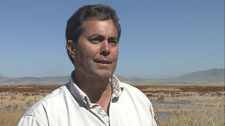 that…”
that…”
Ron Cole manages the Klamath Basin National Wildlife
Refuges. He also serves as the project leader for Walking
Wetlands, a unique crop rotation program that marries
agricultural land with wetlands.
Ron Cole, Refuge Manager / Klamath Basin National
Wildlife Refuges: “And I told them I'm not sure about
wanting to put potatoes on it but I know someday you're
going to want a wetland on your farm. And there was a
chuckle and that same individual is now a big proponent of
putting wetlands on farm ground and has one on his own farm
today and is very proud of it because it's working for his
operation.
In the battle over water rights and land use in
California and Oregon, the Klamath Water Basin has long been
the “Tip of the spear.” In 2001,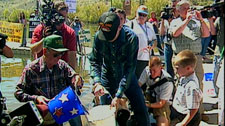 agriculture in the basin was pitted against endangered
suckerfish and salmon interests, when the federal government
denied farmers access to water needed to irrigate fields.
20,000 people gathered in Klamath Falls to protest the
decision. The demonstrators formed a bucket brigade, took
water from Klamath Lake and dumped it into an irrigation
canal. The gesture was symbolic but it drew national
attention to the century-old dispute of how water is used in
the basin.
agriculture in the basin was pitted against endangered
suckerfish and salmon interests, when the federal government
denied farmers access to water needed to irrigate fields.
20,000 people gathered in Klamath Falls to protest the
decision. The demonstrators formed a bucket brigade, took
water from Klamath Lake and dumped it into an irrigation
canal. The gesture was symbolic but it drew national
attention to the century-old dispute of how water is used in
the basin.
Prior to the 1900’s, the Klamath Basin was made up of
over 180,000 acres of shallow lakes and wetlands, making it
one the largest and most important feeding and breeding
grounds for waterfowl that migrate along the Pacific Flyway.
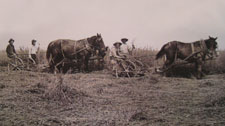 Despite the
ecosystems intrinsic value, the federal government in 1905
initiated the Klamath Reclamation Project. The goal of the
project was to drain wetlands and build canals for
irrigation beneath the Lower Klamath and Tule Lake in order
to create farmland and encourage homesteading. Three years
later, President Theodore Roosevelt recognized the
importance of the wetlands and created the nations first
waterfowl refuge on the Lower Klamath. Since then, the basin
has become a patchwork of reclamation and preservation
projects, which have resulted in numerous court battles
between agriculturalists and preservationists.
Despite the
ecosystems intrinsic value, the federal government in 1905
initiated the Klamath Reclamation Project. The goal of the
project was to drain wetlands and build canals for
irrigation beneath the Lower Klamath and Tule Lake in order
to create farmland and encourage homesteading. Three years
later, President Theodore Roosevelt recognized the
importance of the wetlands and created the nations first
waterfowl refuge on the Lower Klamath. Since then, the basin
has become a patchwork of reclamation and preservation
projects, which have resulted in numerous court battles
between agriculturalists and preservationists.
Dave Mauser, Wildlife Biologist / Klamath Basin Wildlife
Refuge: ”Fighting each other about water, about pesticides,
about a host of issues and while you're in those battles and
your lawyers are talking to their lawyers you're not
negotiating, you're not talking about things that you
mutually agree upon.”
Dave Mauser is a Wildlife Biologist
 at the
Klamath Basin Wildlife Refuges. Since the refuges contain
land leased for farming, Mauser along with Refuges Manager
Ron Cole developed the idea of draining wetlands to create
farmland, and flooding farmland to create wetlands. They
felt Walking Wetlands could benefit both farming and
wildlife and be the common ground on which both
preservationist and agriculturalist could stand. So far the
benefits have been greater than anticipated.
at the
Klamath Basin Wildlife Refuges. Since the refuges contain
land leased for farming, Mauser along with Refuges Manager
Ron Cole developed the idea of draining wetlands to create
farmland, and flooding farmland to create wetlands. They
felt Walking Wetlands could benefit both farming and
wildlife and be the common ground on which both
preservationist and agriculturalist could stand. So far the
benefits have been greater than anticipated.
Marshall Staunton, Tulelake Farmer: “And we had the
university come out and do a replicated yield trial in three
different spots and we hit the incredible 35 ton yield in
one spot, 30 ton yield in another. Typical yield was 25 ton
or 500 sacks we call it. And so potatoes, and so we here we
had this great big potato crop and a great big grain crop in
the two years after wetland…”
Marshall Staunton’s family was the first in the basin to
take part in the Walking Wetland program. What they found
was not only a 25 percent increase yields, but also a
decrease in their use of fertilizer and pesticides.
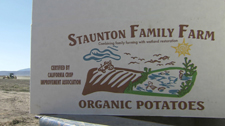 Prior to
the Walking Wetlands program, growing potatoes in the basin
without fumigating for nematodes was impossible. But,
Staunton found that a former wetland can be farmed without
inputs for a few years, and that has allowed him to produce
a portion of his crops organically.
Prior to
the Walking Wetlands program, growing potatoes in the basin
without fumigating for nematodes was impossible. But,
Staunton found that a former wetland can be farmed without
inputs for a few years, and that has allowed him to produce
a portion of his crops organically.
Marshall Staunton, Tulelake Farmer: “But, if you aren't
into organic and you want to go conventional you've got
those cost saving and yield.”
With yields up as much as 25%, a reduction in input costs
and the ability to command a higher price by marketing
organic produce, the cost of leasing land coming out of a
wetland rotation is 75-100% higher than other land in the
refuge. The benefits realized in the Walking Wetlands
program have farmers like Rob Crawford preparing their
private lands for wetland rotations. A year ago, this is
where Crawford planted his crops. Today the same land is
underwater.
Rob Crawford, Tulelake
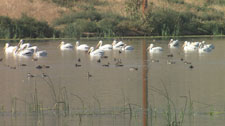 Farmer:
“That's the amazing thing to stand here today and to realize
it was red wheat, a spring red wheat crop last year and that
this spring was the first application of water and just to
watch that quick realization of benefit for the wildlife.”
Farmer:
“That's the amazing thing to stand here today and to realize
it was red wheat, a spring red wheat crop last year and that
this spring was the first application of water and just to
watch that quick realization of benefit for the wildlife.”
Crawford worked with the U.S. Fish and Wildlife Service
to build the levees that surround his field. In return for
taking his own land out of production, the government allows
him to farm within the refuge. And for Crawford that’s a
win-win situation.
Rob Crawford, Tulelake Basin Farmer: “People need to get
back to the, to understand the value of fertile land and at
the same time if you can do something that is beneficial for
wildlife and still make your lands more fertile, and
economically justify what you're doing… That's a good
strategy.”
 In
addition to it’s agricultural benefits, the Walking Wetland
program has had a huge impact on refuges within the basin.
While less than 25 percent of the Klamath’s historic
wetlands exist today, the Walking Wetlands program has added
nearly 4,000 acres of additional wetlands. That in turn, has
prompted a 50-75% increase in waterfowl. Because farmers are
using less fertilizer and pesticides, water quality has
improved benefiting wildlife not only within the basin but
downstream as well. And, there is also the benefit of
increased revenues from farmers who are willing to pay more
for land leased within the refuge.
In
addition to it’s agricultural benefits, the Walking Wetland
program has had a huge impact on refuges within the basin.
While less than 25 percent of the Klamath’s historic
wetlands exist today, the Walking Wetlands program has added
nearly 4,000 acres of additional wetlands. That in turn, has
prompted a 50-75% increase in waterfowl. Because farmers are
using less fertilizer and pesticides, water quality has
improved benefiting wildlife not only within the basin but
downstream as well. And, there is also the benefit of
increased revenues from farmers who are willing to pay more
for land leased within the refuge.
Ron Cole, Refuge Manager / Klamath Basin National
Wildlife Refuges: “You know we call it walking wetlands and
they were taking some tiny steps to start with but the legs
are getting pretty strong and they're moving
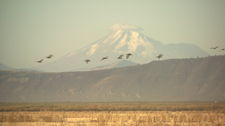 pretty
fast now and I love it. I like where it's going. I like the
stride it's taking.”
pretty
fast now and I love it. I like where it's going. I like the
stride it's taking.”
For “Market to Market” I’m Andrew Batt.

